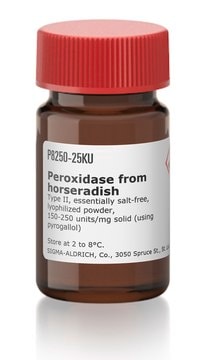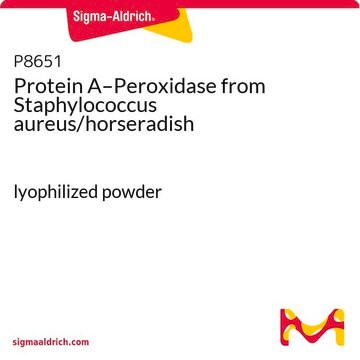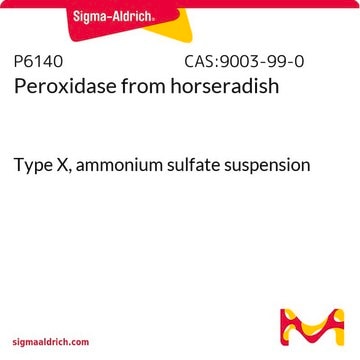11428861001
Roche
Peroxidase (POD), activated
from horseradish
Sinonimo/i:
POD
About This Item
Prodotti consigliati
Origine biologica
horseradish
Livello qualitativo
Forma fisica
lyophilized
Attività specifica
800 units/mg protein (at 25 °C with ABTS and H2O2 as substrate (pH 5.0).)
Confezionamento
pkg of 8 mg (~40 mg lyophilizate)
Produttore/marchio commerciale
Roche
pH ottimale
6.0-6.5
Condizioni di spedizione
wet ice
Temperatura di conservazione
2-8°C
Categorie correlate
Descrizione generale
Reagent for the labeling of water-soluble substances carrying primary amino groups with peroxidase from horseradish (HRP).
Capacity: sufficient for approximately 6 mg IgG.
Applicazioni
Azioni biochim/fisiol
Qualità
Purity number: 3.0 - 3.5 (A403/A275)
Nota sulla preparazione
Working concentration: 1:4,000 to 1:10,000
For ELISA
Working solution: Preparation of the solutions, (15 to 25 °C)
1. 1 M Sodium carbonate/-hydrogencarbonate solution, pH 9.4
1 M Na2CO3: Dissolve 10.6 g Na2CO3 in 80 ml double-dist. water and make up to 100 ml.
1 M NaHCO3: Dissolve 8.4 g NaHCO3 in 80 ml double-dist. water and make up to 100 ml.
Adjust the pH of the NaHCO3 solution to 9.4 by adding Na2CO3 solution.
2. 100 mM Sodium carbonate/-hydrogencarbonate solution, pH 9.8
Dilute 10 ml solution 1 to 100 ml with double-dist. water.
3. 200 mM Sodium borohydride solution
NB: Prepare the solution immediately prior to use and keep cold on ice. Dissolve 8 mg NaBH4 in 1 ml cold double-dist. water.
4. 2 M Triethanolamine solution, pH 8.0
Dilute 2.66 ml triethanolamine with 3 ml double-dist. water, adjust the pH to 8.0 with 25% HCI and make up to 10 ml with double-dist. water.
5. 1 M Glycine solution, pH 7.0
Dissolve 0.75 g glycine in ca. 6 ml double-dist. water, adjust to pH 7.0 with 0.1 M NaOH, and make up to 10 ml with double-dist. water.
6. PBS (phosphate-buffered saline); glycine; pH 7.4.
10 mM Potassium phosphate, 200 mM NaCI, 10 mM glycine, pH 7.5.
- Solution A (K2HPO4): Dissolve 4.56 g K2HPO4 × 3 H2O, 23.4 g NaCI, and 1.5 g glycine in ca. 1,500 ml double-dist. water and make up to 2000 ml with double-dist. water.
- Solution B (KH2PO4): Dissolve 2.72 g KH2PO4, 23.4 g NaCI, and 1.5 g glycine in ca. 1,500 ml double-dist. water and make up to 2,000 ml with double-dist. water.
- PBS: Whilst controlling pH, add sufficient solution B to solution A until the pH is 7.4.
7. Antibody solution
0.3 ml required for each labeling reaction. The IgG concentration of the solution to be used is c = 4 mg/ml (3.8–42 mg/ml). This value is critical for the coupling and hence should be checked photo-metrically for every test and adjusted if necessary: A280nm, 1cm, 1 mg/ml = 1.40.
NB: Do not use preservatives (e.g., sodium azide) and stabilizers (e.g., albumin).
- Immunoglobulin, salt-free, lyophilized:
- Immunoglobulin in buffer:
Stability of the solutions
Solutions 1, 2, 4, 5 and 6 are stable for 1 week at 2 to 8 °C. Solutions 3 and 7 should always be prepared immediately prior to use.
Storage conditions (working solution): The reconstituted solution is stable for 3 months at 2 to 8 °C. The solution can be aliquoted and shock-frozen at -60 °C or below, and then stored at -15 to -25 °C; a loss of activity of 10–20 % can result.
Ricostituzione
Altre note
Avvertenze
Danger
Indicazioni di pericolo
Consigli di prudenza
Classi di pericolo
Resp. Sens. 1 - Skin Sens. 1
Codice della classe di stoccaggio
11 - Combustible Solids
Classe di pericolosità dell'acqua (WGK)
WGK 1
Punto d’infiammabilità (°F)
does not flash
Punto d’infiammabilità (°C)
does not flash
Certificati d'analisi (COA)
Cerca il Certificati d'analisi (COA) digitando il numero di lotto/batch corrispondente. I numeri di lotto o di batch sono stampati sull'etichetta dei prodotti dopo la parola ‘Lotto’ o ‘Batch’.
Possiedi già questo prodotto?
I documenti relativi ai prodotti acquistati recentemente sono disponibili nell’Archivio dei documenti.
I clienti hanno visto anche
Il team dei nostri ricercatori vanta grande esperienza in tutte le aree della ricerca quali Life Science, scienza dei materiali, sintesi chimica, cromatografia, discipline analitiche, ecc..
Contatta l'Assistenza Tecnica.








